
Summary
Mubarak Mandi is a palace in the city of Jammu in Jammu and Kashmir, India. The palace was the royal residence of the maharaja of Jammu and Kashmir from the Dogra dynasty. It was their main seat till 1925 when maharaja Hari Singh moved to the Hari Niwas Palace in the northern part of Jammu. The palace is located in the heart of the old walled city of Jammu and overlooks the Tawi river. The architecture is a mix of Rajasthani architecture and European baroque, and Mughal styles. Successive maharajas added to the complex in size and building took more than 150 years.





History edit
The foundation of the Mubarak Mandi palace was laid by Raja Dhruv Dev in 1710 after consulting astrologers.[1]
Between 1856 and 1885, Maharaja Ranbir Singh (1830-1885) constructed palaces for his queen and himself on the north eastern side of the palace complex, with terrace gardens.[1] In addition, he also built palaces for his three sons within the complex, such as the Gole Ghar and the Sheesh Mahal.[1]
Maharaja Pratap Singh (1848-1925) constructed for his queen, Maharani Charak, a palace on the eastern side of the complex, facing the river Tawi.[1] In addition, he reconstructed and renovated the palace complex. In 1899, a fire caused serious damage to a number of buildings, mainly the Durbar hall and the Dewani Daftar.[1] Also, a significant number of historical records were destroyed.[1]
After the accession of Maharaja Hari Singh (1895-1961) in 1925, the royal residence moved to the Hari Niwas palace, which is next to the Amar Mahal palace in the north of Jammu.[1] However, the Mubarak Mandi complex remained the political centre of the Dogra princes.[1]
Nowadays sections of the palace house government offices, courts and the Dogra Art Museum. However, other parts of the palace are in ruins as the palace has more than 36 times has been the victim of fires. Furthermore, the building suffered from earthquakes in the 1980s and in 2005.
Architecture edit
The complex is grouped around several courtyards and includes various buildings and palaces like the Darbar Hall Complex, the Pink Palace, Royal Courts buildings, Gol Ghar Complex, Nawa Mahal, Rani Charak Palace, Hawa Mahal, the Toshakhana palace and the Sheesh Mahal. The halls and galleries of the palace were used for official functions and ceremonies.
The Dogra art museum is situated within the ‘Pink Hall’. It has a rich collection containing miniature paintings of various styles of the region. The miniatures belong to the Kangra, Jammu and the Basholi art schools. But it also has a gold painted bow and arrow of Mughal emperor Shah Jahan. The pink hall owes its name to the pink plastered walls of the palace section.
The Gol Ghar section is located in the southern part of the complex. It has four storeys and overlooks the Tawi river. It has been gutted down in the mid-1980s as a result of an earthquake. Consequently, roofs and floors collapsed, leaving the building as a ruin.
The Sheesh Mahal is made entirely of glass.
The palace, which is a heritage site declared by the state government, is proposed to be linked with a rope way running up to the Bahu Fort, another heritage site in the city.
References edit
Bibliography edit
- Jerath, Ashok (2000). Forts and Palaces of the Western Himalaya. New Delhi: Indus Publishing House. p. 160. ISBN 9788173871047.
- Chaudhary, Poonam; Singh Katoch, Jasbir (2008). Mubarak Mandi Palace - Inheritance Of An Ailing Heritage. Jammu. Jammu: Saksham Books International. p. 102. ISBN 978-81-89478-11-7.
- Singh, Amrita; Sehjowalia, Aritik; Atwal, Neha; Grover, Sehajpreet; Sharma, Parul (2017). Mubarak Mandi Complex Jammu (Documentation Study Report). p. 119.
External links edit
- Forum post about the Mubarak Mandi palace
- Website from a conservation enterprise working at the Mubarak Mandi
- Website from Jammu city on local sights
- Article on Mubarak Mandi Palace


